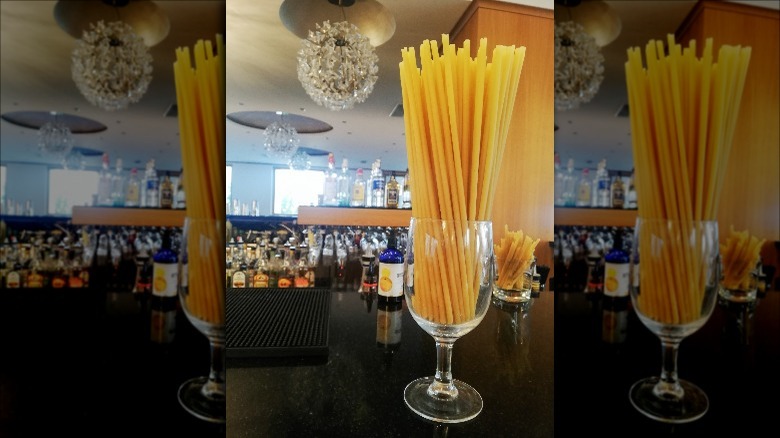The Real Reason Some Restaurants Are Using Pasta To Replace Plastic Straws
Plastic straws have become the poster child for needless human waste. They aren't necessarily the biggest part of Earth's plastic problem. The Plastic Pollution Coalition reported that straws may comprise less than 0.025% of the world's ocean plastic. (Even so, a lot of people saw a painful-to-watch video of someone removing a plastic straw from a sea turtle's nose.) Plastic straws are especially problematic because they have a useful lifetime of only a few minutes — however long it takes to polish off that to-go milkshake or movie theater soda.
This is not to say that nobody should use straws, period. Nation Swell points out that some people with disabilities require straws for eating or drinking in a public setting. But nobody said straws must be plastic, especially since a number of more environmentally friendly alternatives are available. Starbucks has seen the light, having ditched the straw last year (via Thrillist). Their solution was to make a lid with a wider opening that allows your mouth to go straight to the cup, according to the Starbucks website. Not everyone is won over by Starbucks' breakthrough, though. In its list of 11 plastic straw alternatives, Thrillist ranked the new wide-mouth lid dead last.
Paper straws are about as useful as a wet paper bag. Reusable metal straws require a level of commitment — regular treatments with a cleaning brush, one more thing to not lose — that our society may not be ready for. Enter the pasta straw: sturdy-ish and biodegradable with no metallic flavor.
Some pasta straws are even gluten-free
Substituting pasta straws for plastic isn't all that new. By 2019, the world and Insider, in particular, were discovering that store-bought pasta already came in a straw shape. You could buy a whole package of bucatini for a couple bucks and have your own personal supply of biodegradable straws. Bucatini wasn't invented to transport liquids from cup to mouth, so it makes for a less than ideal straw. It's a little too narrow, and it dissolves fairly quickly in iced coffee. That's why some restaurants have opted for pasta straws that were devised to be straws — a little sturdier and wider than your basic bucatini (via Food & Wine). The straw should last about an hour before becoming too soggy, but that should be long enough for everyone but the slowest of drinkers.
The Strategist found some restaurants in Brooklyn and Lower Manhattan that have embraced a pasta straw that has the added benefit of being gluten-free — made with rice and tapioca flour. They do well in everything from sparkling water to iced coffee, thicker smoothies, and even tequila and tonics, without imparting any pasta flavor. Restaurant managers say they're an improvement over paper or grass straws. They even make great conversation starters. "Guests are usually in disbelief," the head of operations at a Lower East Side restaurant told The Strategist.
Believe it. Pasta straws may become less of a curiosity and more of a mainstay — to the great relief of the world's sea turtles.

